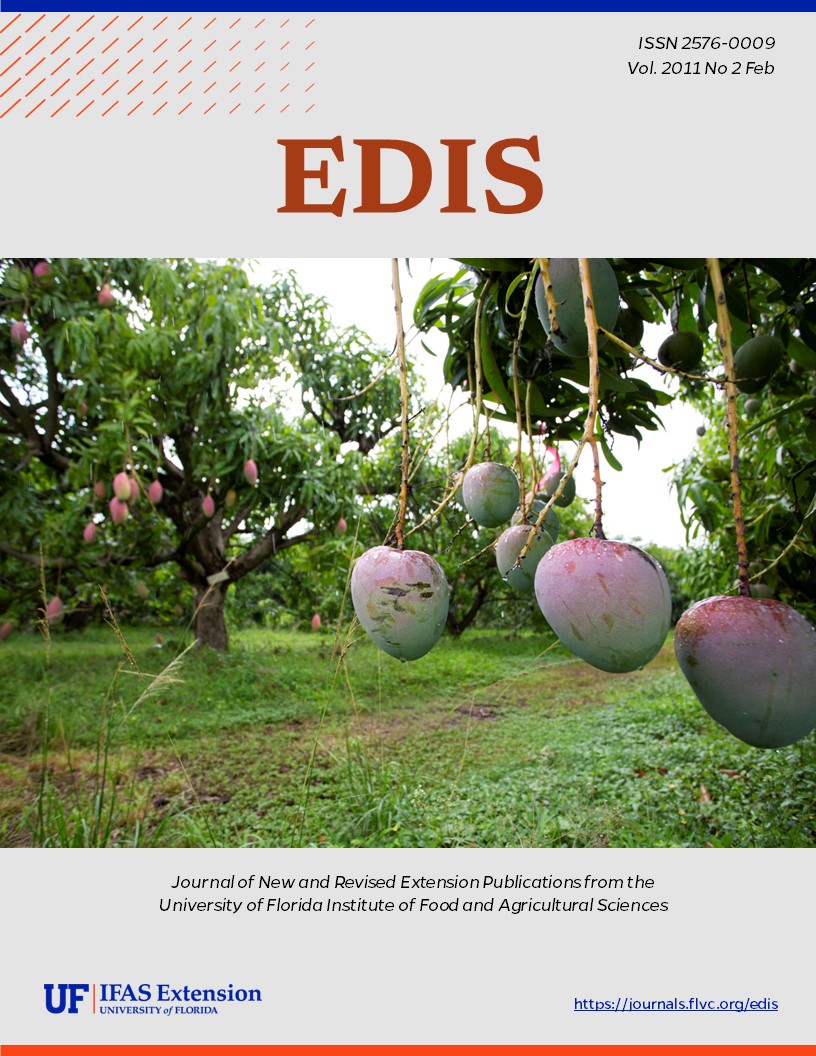Abstract
Three techniques are currently in use to sample adult Asian citrus psyllids (ACP). This 7-page illustrated fact sheet by H. A. Arevalo, J. A. Qureshi, and P. A. Stansly discusses the strengths and weaknesses of each and makes recommendations for routine monitoring of ACP for management purposes. Includes references. Published by the UF Department of Entomology and Nematology, September 2010.
References
APHIS-USDA. 2009. Citrus Greening. Animal and Plant Health Inspection Service.
GOTTWALD, T., AUBERT, B., ZHAO, X., BERGAMIN-FILHO, A., BASSANEZI, R., AND AMORIM, L. 2006. Huanglongbing epidemiology: An international perspective. Proceedings of Huanglongbing-greening International Workshop, July 14-21, 2006, Ribeiro Preto, Brazil 35-36.
HALBERT, S. E. 2005. Citrus greening/Huanglongbing. Department of Agriculture and Consumer Services, Division of Plant Industry, Gainesville, FL.
HALBERT, S. E., AND MANJUNATH, K. L. 2004. Asian citrus psyllids (Sternorrhyncha: Psyllidae) and greening disease of citrus: a literature review and assessment of risk in Florida. Florida Entomologist 87 (3): 330-353. https://doi.org/10.1653/0015-4040(2004)087[0330:ACPSPA]2.0.CO;2
HALL, D. 2009. An assessment of yellow sticky card traps as indicators of the abundance of adult Diaphorina citri (Hemiptera: Psyllidae) in Citrus. Journal of Economic Entomology 102 (1): 446-452. https://doi.org/10.1603/029.102.0158
HALL, D. G., AND HENTZ, M. G. 2010. Sticky trap and stem-tap sampling protocols for the Asian citrus psyllid (Hemiptera: Psyllidae). Journal of Economic Entomology 103 (2): 541-549. https://doi.org/10.1603/EC09360
HALL, D. G., HENTZ, M. G., AND CIOMPERLIK, M. A. 2007. A comparison of traps and stem tap sampling for monitoring adult Asian citrus psyllid (Hemiptera : Psyllidae) in citrus. Florida Entomologist 90 (2): 327-334. https://doi.org/10.1653/0015-4040(2007)90[327:ACOTAS]2.0.CO;2
LIU, Y. H., AND TSAI, J. H. 2000. Effects of temperature on biology and life table parameters of the Asian citrus psyllid, Diaphorina citri Kuwayama (Homoptera : Psyllidae). Annals of Applied Biology 137 (3): 201-206. https://doi.org/10.1111/j.1744-7348.2000.tb00060.x
MERCADO, B. G., ARANO, B., BARAIRO, G. A., GONZALES, C. I., AND GAVARRA, M. 1991. Monitoring the presence and populations of D. citri using different traps in the Philippines, pp. 594-597. IN B. Huang and Q. Yang [eds.], Proceedings of the International Citrus Symposium Guangzhou, China, Nov. 5-8, 1990. International Academic Publishers, Beijing.
MURARAO, RP. 2009. Summary of 2008 - 2009 Citrus Budget for the Southwest Florida Production Region. University of Florida, IFAS, CREC, Lake Alfred, FL [http://www.crec.ifas.ufl.edu/extension/economics/pdf/SW_Budget_Summ_2008-2009.pdf ]
QURESHI, J. A., AND STANSLY, P. A. 2007. Integrated approaches for managing the Asian citrus psyllid Diaphorina citri (Homoptera: Psyllidae) in Florida. Proceedings of the Florida State Horticultural Society. 120 : 110-115
QURESHI, J. A., AND STANSLY, P. A. 2009. Exclusion techniques reveal significant biotic mortality suffered by Asian citrus psyllid Diaphorina citri (Hemiptera: Psyllidae) populations in Florida citrus. Biological Control 50(2):129-136. https://doi.org/10.1016/j.biocontrol.2009.04.001
QURESHI, J.A., ROGERS, M.E., HALL, D.G., STANSLY, P.A., 2009. Incidence of invasive Diaphorina citri (Hemiptera: Psyllidae) and its introduced parasitoid Tamarixia radiata (Hymenoptera: Eulophidae) in Florida citrus. J. Econ. Entomol. 102, 247-256. https://doi.org/10.1603/029.102.0134
QURESHI, J. A., AND STANSLY, P. A. 2010. Dormant season foliar sprays of broad-spectrum insecticides: An effective component of integrated management for Diaphorina citri (Hemiptera: Psyllidae) in citrus orchards. Crop Protection. 29 (8): 860-868. https://doi.org/10.1016/j.cropro.2010.04.013
SAMWAYS, M. J., TATE, B. A., AND MURDOCH, E. 1986. Monitoring the citrus thrips and psylla using fluorescent yellow sticky traps- a practical guide. The Citrus and Subtropical Fruit Journal 629: 9-15.
SOUTHWOOD, R., AND HENDERSON, P. A. 2000. Ecological methods. 3rd edition. Blackwell Pub.
STANSLY, P. A., QURESHI, J. A., AND AREVALO, H. A. 2009. Why, when and how to monitor and manage Asian citrus psyllid. Citrus Industry Magazine 90(3):24-26.
STANSLY, P. A., AREVALO, H. A., AND QURESHI, J. 2010. Monitoring methods for Asian citrus psyllid. Citrus Industry Magazine. 91(4): 20-22.
SUTTON, B. D., DUAN, Y.-P., HALBERT, S., SUN, X.-A., SCHUBERT, T., AND DIXON, W. 2005. Detection and identification of citrus huanglongbing (greening) in Florida, USA, pp. 59. IN T. R. Gottwald, W. N. Dixon, J. H. Graham and P. Berger [eds.], Proc. of the 2nd Intl. Citrus Canker and Huanglongbing Workshop 7-11 November. Florida Citrus Mutual, Orlando, FL USA.
VAN DEN BERG, M., AND DEACON, V. E. 1988. Dispersal of the citrus psylla, Trioza erytreae (Hemiptera: Triozidae) in the absence of its host plants. Phytophylactica 20 (4): 361-368.

